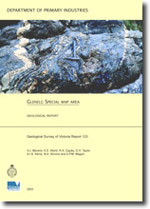GSV Report 123 - Glenelg special map area geological report
 |
| |||||||||||||||||||||||||||||||||||||||||||||||||||||||||||||||||||||||||||||||||||||||||||||||||||||||||||||||||||||||||||||||||||||||||||||
Product description:Download The downloadable version of this report is supplied in PDF format and is a large file (23.3MB). Abstract This report describes the geology of the area (referred to as GLENELG) covered by the Edenhope 1:100 000 mapsheet 7123, the Balmoral 1:100 000 mapsheet 7223 and the northern part of the Coleraine 1:100 000 mapsheet 7222. It contains a summary of previous work and gives a comprehensive account of the physiography, geological history, landscape evolution and structural and economic geology. The geological and geophysical characteristics of Palaeozoic and Cainozoic rock units are described, and depositional settings are discussed for each. The text is supported by numerous illustrations, there is a comprehensive list of references, and a detailed excursion guide designed to show the major geological features. GLENELG straddles the Glenelg Zone and part of the Grampians–Stavely Zone in far western Victoria. Both these zones consist of ?Neoproterozoic to Cambrian rocks which were deformed and uplifted during deformation attributed to arc-continent collision in the Cambrian Delamerian Orogeny. These zones form the easternmost parts of the Delamerian Fold Belt exposed in southeastern Australia. They are remote from other exposures of the Delamerian Fold Belt, which lie farther northwest and north in South Australia and western New South Wales. The intervening areas are covered by younger sedimentary rocks of the Murray and Otway basins, which overlie the Cambrian basement. The Otway Basin extends into the southern part of the map area, while the Murray Basin covers the northern part of GLENELG, connecting with the Otway Basin to the west. There is a widespread veneer of thin Pliocene sandstone and ferricrete developed upon much of the pre-Neogene rock in GLENELG. Geophysical data are used to extend the Palaeozoic geology exposed in numerous deeply incised creeks beneath this younger cover. The Glenelg Zone comprises deep-marine parts of the Adelaide Geosyncline passive margin sequence that was deposited outboard of the Australian craton in late Proterozoic to Cambrian times. The exposed sequence includes Cambrian, low greenschist facies grade marine turbiditic sedimentary rocks (Nangeela Formation), that includes some thick intervals of greywacke (Steep Bank Greywacke Member) and minor carbonate (Warrock Limestone Member), that are all interlayered with mafic volcanics (Truro Volcanics). There are fault-slices of ultramafic rock (Hummocks Serpentinite and others) which may be allochthonous. All these rocks have been cut by northwest-trending faults, and show a single generation of folds and related cleavage. These structurally simple rocks grade east into a belt of high-T low-P Cambrian metamorphics, a region known as the Glenelg River Metamorphic Complex. Metamorphic rocks in the complex include pelitic schists, calc-silicate, and minor mafic (amphibolite) and ultramafic (talc) schist, all with compositions consistent with derivation from the exposed lower grade rocks. With increasing grade metamorphic rocks pass through the biotite, garnet, staurolite, sillimanite and migmatite zones. Structural complexity appears directly linked to metamorphic grade, with high-grade schists preserving several overprinting generations of quartz-veining, schistosity and tight crenulation folding. Partial melting is well developed in parts of the complex, with common stromatic and nebulitic migmatite, grading to syn-tectonic granite. Syn- and post-tectonic Cambrian granite intrusions are widespread. The Glenelg River Metamorphic Complex is bounded along its eastern margin by the Yarramyljup Fault, a major west-side-up fault of unknown but steep dip, which forms the boundary between the Glenelg and Grampians–Stavely Zones. In GLENELG the Grampians–Stavely Zone comprises very low-grade intermediate volcanics (Mount Stavely Volcanic Complex) overlain by marine sedimentary rocks (Nargoon Group), which were deposited and then weakly deformed within a short period during the final stages of the Delamerian Orogeny. Unconformably overlying the Cambrian basement of both zones is the ?Late Ordovician–Siluran Grampians Group, a fluvial to shallow-marine quartzose sandstone sequence derived in part from uplifted and eroded Delamerian Fold Belt rocks. Following predominantly extensional deformation in the Late Silurian, much of the Grampians Group was eroded from above the Glenelg Zone, where only a few scattered outcrops remain, while large parts of the Grampians–Stavely Zone are covered by a veneer of Grampians Group. GLENELG appears to have remained remarkably tectonically stable since the Early Devonian by comparison with other parts of Victoria. Cover rocks in GLENELG include the undeformed Early Devonian Rocklands Volcanic Group, which is particularly widespread over the Grampians–Stavely Zone, Permian diamictite (Bacchus Marsh Formation), Jurassic mafic to intermediate volcanics and Mesozoic–Cainozoic fluvial to marine sedimentary rocks of the Otway and Murray basins. A low relief landscape (the Dundas Tableland) with a well-developed ferricrete duricrust that covers much of the geology has probably developed intermittently since the Permian. The post-Palaeozoic history is one of deep weathering and minor uplift along a central spine flanked by basin development as Australia and Antarctica rifted apart. The Otway Basin in the south is a passive continental margin rift and fill succession, and the younger Murray Basin to the north is an intracontinental sag basin. Regional uplift and dissection of the Dundas Tableland began in the Pliocene and continues today. GLENELG has limited known resources of basement-hosted economic mineralisation, with only minor occurrences of lead-zinc and gold. However, the southern margin of the Murray Basin in GLENELG has large tracts of Pliocene Parilla Sand, preserved as a series of subparallel dunes or 'strandlines' deposited during the final retreat of the sea from the basin in the Late Pliocene. These contain important deposits of placer heavy minerals. Bibliographic reference Morand, V.J., Wohlt, K.E., Cayley, R.A., Taylor, D.H., Kemp, A.I.S., Simons, B.A. & Magart, A.P.M., 2003. Glenelg special map area geological report. Geological Survey of Victoria Report 123, Geological Survey of Victoria. Related products:
| ||||||||||||||||||||||||||||||||||||||||||||||||||||||||||||||||||||||||||||||||||||||||||||||||||||||||||||||||||||||||||||||||||||||||||||||











